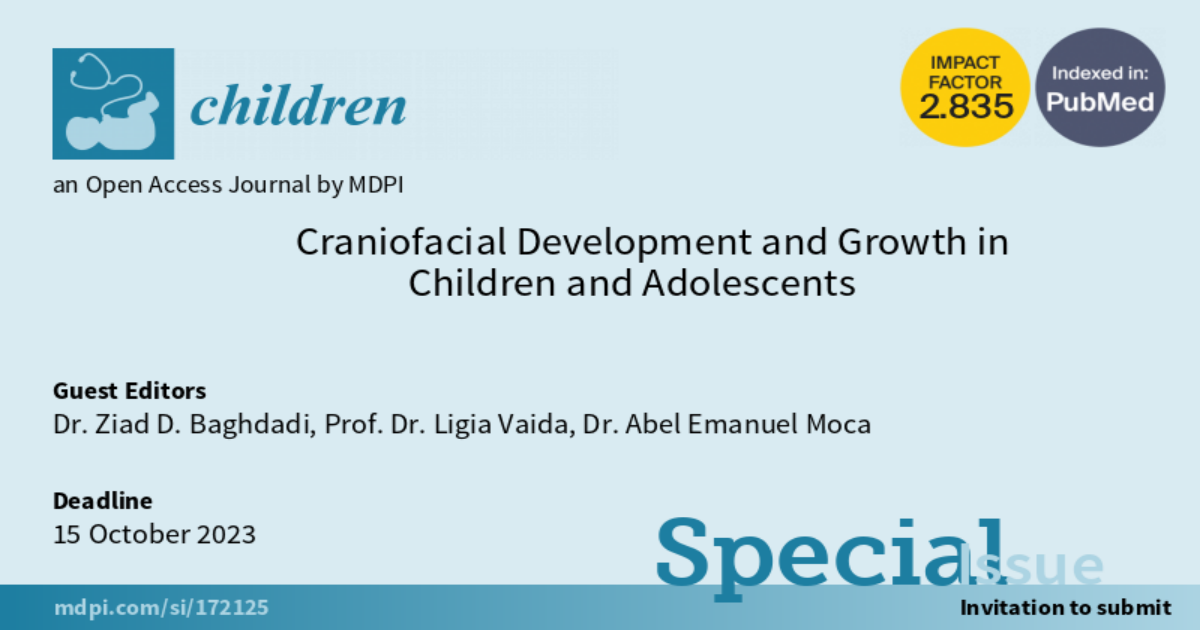Craniofacial Development and Growth in Children and Adolescents
A special issue of Children (ISSN 2227-9067). This special issue belongs to the section "Pediatric Dentistry".
Deadline for manuscript submissions: 1 June 2024 | Viewed by 1212

Special Issue Editors
Interests: dental public health; clinical pediatric dentistry; nonpharmacological techniques for managing children at the dental office; oral rehabilitation under general anesthesia
Special Issues, Collections and Topics in MDPI journals
Interests: orthognathic treatment
Special Issues, Collections and Topics in MDPI journals
Interests: craniofacial growth and development; pediatric dentistry; early interventions in orthodontics
Special Issue Information
Dear Colleagues,
Background & history of this topic: Craniofacial development in children and adolescents continues to be of major interest in the field of pediatric dentistry and orthodontics. New means of investigating dental, skeletal and craniofacial development in children and adolescents emerge constantly, and the old methods are resumed and reinterpreted. The process of tooth eruption is still incompletely understood and requires in-depth study, and dental anomalies are various and have important effects on the child's development. Additionally, the therapeutic methods for correcting dento-maxillary anomalies during growth are designed to influence and direct craniofacial development in an optimal and desired direction.
Aim and scope of the Special Issue: The purpose of this Special Issue is to inform readers and other authors about the different methods that can be used to influence harmonious craniofacial growth and development in children and adolescents. This Special Issue also aims to present the different methods of estimating the dental and skeletal age of children in various populations, while also investigating dental anomalies as well as eruption discrepancies in children and adolescents.
Cutting-edge research: New discoveries in the physiology and pathology of tooth eruption, new information regarding dental anomalies and their treatment, and the adaptation of different methods for estimating dental and skeletal age in various populations represent important information that can contribute to the literature. New information about dento-maxillary anomalies, as well as their treatment, would be extremely useful in everyday practice.
What kind of papers we are soliciting: This Special Issue is accepting research articles that present the epidemiology of dento-maxillary anomalies and eruption discrepancies. Original articles that investigate dental eruption, dental age, or skeletal age can be submitted as well. Review articles and case reports dealing with the previously mentioned topics are also welcome.
Dr. Ziad D. Baghdadi
Prof. Dr. Ligia Vaida
Guest Editors
Dr. Abel Emanuel Moca
Guest Editor Assistant
Manuscript Submission Information
Manuscripts should be submitted online at www.mdpi.com by registering and logging in to this website. Once you are registered, click here to go to the submission form. Manuscripts can be submitted until the deadline. All submissions that pass pre-check are peer-reviewed. Accepted papers will be published continuously in the journal (as soon as accepted) and will be listed together on the special issue website. Research articles, review articles as well as short communications are invited. For planned papers, a title and short abstract (about 100 words) can be sent to the Editorial Office for announcement on this website.
Submitted manuscripts should not have been published previously, nor be under consideration for publication elsewhere (except conference proceedings papers). All manuscripts are thoroughly refereed through a single-blind peer-review process. A guide for authors and other relevant information for submission of manuscripts is available on the Instructions for Authors page. Children is an international peer-reviewed open access monthly journal published by MDPI.
Please visit the Instructions for Authors page before submitting a manuscript. The Article Processing Charge (APC) for publication in this open access journal is 2400 CHF (Swiss Francs). Submitted papers should be well formatted and use good English. Authors may use MDPI's English editing service prior to publication or during author revisions.
Keywords
- tooth eruption
- dental age
- skeletal age
- craniofacial development
- craniofacial growth
- dental anomalies
- dento-maxillary anomalies








